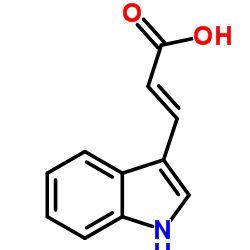3-Indoleacrylic acid

3-Indoleacrylic acid structure
|
Common Name | 3-Indoleacrylic acid | ||
|---|---|---|---|---|
| CAS Number | 29953-71-7 | Molecular Weight | 187.195 | |
| Density | 1.4±0.1 g/cm3 | Boiling Point | 432.8±20.0 °C at 760 mmHg | |
| Molecular Formula | C11H9NO2 | Melting Point | 185 °C (dec.)(lit.) | |
| MSDS | Chinese USA | Flash Point | 215.6±21.8 °C | |
| Symbol |

GHS07 |
Signal Word | Warning | |
|
Tryptophan 2,3-dioxygenase (TDO) inhibitors. 3-(2-(pyridyl)ethenyl)indoles as potential anticancer immunomodulators.
J. Med. Chem. 54 , 5320, (2011) Tryptophan catabolism mediated by indoleamine 2,3-dioxygenase (IDO) is an important mechanism of peripheral immune tolerance contributing to tumoral immune resistance. IDO inhibition is thus an active area of research in drug development. Recently, our group ... |
|
|
Structural insight into the inhibition of human kynurenine aminotransferase I/glutamine transaminase K.
J. Med. Chem. 52 , 2786-93, (2009) Human kynurenine aminotransferase I (hKAT I) catalyzes the formation of kynurenic acid, a neuroactive compound. Here, we report three high-resolution crystal structures (1.50-1.55 A) of hKAT I that are in complex with glycerol and each of two inhibitors of hK... |
|
|
Glycodendrimers and Modified ELISAs: Tools to Elucidate Multivalent Interactions of Galectins 1 and 3.
Molecules 20 , 7059-96, (2015) Multivalent protein-carbohydrate interactions that are mediated by sugar-binding proteins, i.e., lectins, have been implicated in a myriad of intercellular recognition processes associated with tumor progression such as galectin-mediated cancer cellular migra... |
|
|
NMR studies of the mode of binding of corepressors and inducers to Escherichia coli trp repressor.
Eur. J. Biochem. 235(3) , 804-13, (1996) The binding of the corepressors tryptophan and 5-methyltryptophan and of the inducers 3-indolepropionate, 3-indoleacrylate and 5-methylindole to the Escherichia coli trp repressor have been studied by 1H-NMR spectroscopy. Identification of the resonances of t... |
|
|
Algicidal activity of a dibenzofuran-degrader Rhodococcus sp.
J. Microbiol. Biotechnol. 23(2) , 260-6, (2013) Rhodococcus sp. strain p52, a previously isolated dibenzofuran degrader, could effectively inhibit the growth of cyanobacteria, including species of Microcystis, Anabaena, and Nodularia. When strain p52 was inoculated at the concentration of 7.7×10(7) CFU/ml,... |
|
|
Effect of matrix and solvent on the analysis of novel poly(phenylenevinylene) derivatives by matrix-assisted laser desorption/ionization time-of-flight mass spectrometry.
Rapid Commun. Mass Spectrom. 18(18) , 2146-54, (2004) Six novel poly(phenylenevinylene) (PPV) derivatives carrying butoxy or myrtanyl groups, including poly(2-butoxy-m-phenylenevinylene) (Bu-MPV), poly(2,5-dibutoxy-p-phenylenevinylene-alter-p-phenylenevinylene) (Bu-PPPV), poly(2,5-dibutoxy-p-phenylenevinylene-al... |
|
|
Photosensitized inactivation of infectious DNA by urocanic acid, indoleacrylic acid and rhodium complexes.
Photochem. Photobiol. 59(2) , 189-96, (1994) Naked, infectious single-stranded (ss) and double-stranded (ds) DNA from phages S13 and G4 were irradiated with 308 nm UV radiation in the absence and presence of several photobiologically active compounds: E- and Z-urocanic acid (E- and Z-UA), their methyl e... |
|
|
Molecular basis of the medium-chain fatty acyl-CoA dehydrogenase-catalyzed "oxidase" reaction: pH-dependent distribution of intermediary enzyme species during catalysis.
Biochemistry 33(15) , 4738-44, (1994) In a previous paper, we demonstrated that the medium-chain fatty acyl-CoA dehydrogenase-catalyzed (MCAD-catalyzed) reductive half-reaction of indolepropionyl-CoA proceeds via formation of a chromophoric intermediary species "X" (absorption maximum = 400 nm) a... |
|
|
Effect of inclusion body production on culture turbidity and cell dry weight in growing bacterial cultures.
Biotechnol. Prog. 6(1) , 48-50, (1990) An approach to the optimization of product yield in an inducible inclusion body-producing system is presented. Following induction by indoleacrylic acid (IAA) of a trpLE-HIVgp41 fusion protein, we found a large increase in culture turbidity and single-cell dr... |
|
|
Where does indolylacrylic acid come from?
Amino Acids 17(4) , 401-13, (1999) In addition to the main catabolic routes of tryptophan (Trp), there exist minor and less thoroughly investigated pathways; one of these leads to indolylacrylic acid (IAcrA). IAcrA is a plant growth hormone, whereas its biological role in animals is still obsc... |